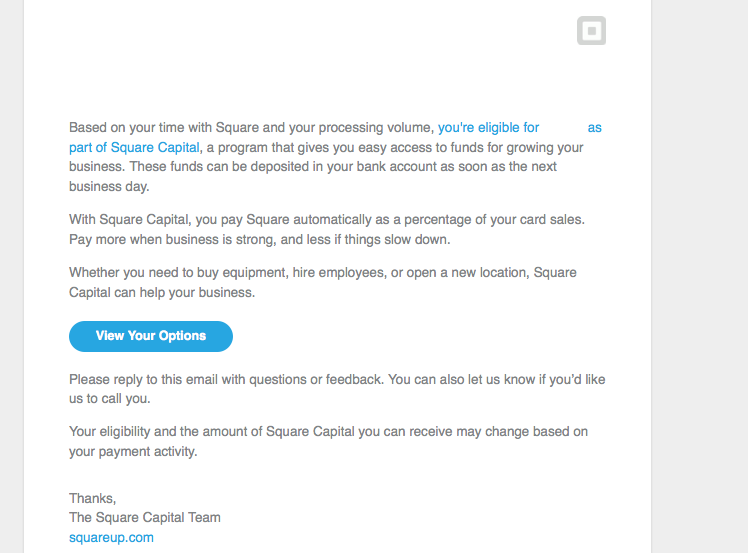Kabbage Has Leverage With Patents
March 23, 2014 If you’re planning on introducing new technology to the merchant cash advance or alternative business lending space, you might want to start filing a patent, or else end up violating someone elses.
If you’re planning on introducing new technology to the merchant cash advance or alternative business lending space, you might want to start filing a patent, or else end up violating someone elses.
I’ve brought up Kabbage and patents before, but another one of theirs caught my attention. In their invention named, Method and Apparatus to Evaluate and Provide Funds in Online Environments, they claim the right to an automated application, scoring, approval, and funding model for online businesses.
Will their claim interfere with what the rest of the industry is already doing or has set their sights on?
Kabbage CEO Rob Frohwein is no amateur to the intellectual property game. With more than 30 patents to his name, Intellectual Asset Magazine once referred to him as one of the world’s top intellectual property strategists. That makes Kabbage a rather dangerous foe in the booming world of alternative lending.
The above referenced patent is summarized as:
(a) receiving mandatory information about a user and storing the mandatory information in an electronic computer database; (b) allowing a user to choose whether to enter optional information about the user, and upon receiving the optional information, storing the optional personal information in the electronic computer database; (c) computing a score using the mandatory information and optional information if provided; and (d) determining whether to approve a transfer of funds using the score, and upon approval initiating an electronic transfer of funds from a cash server to an account associated with the user, (e) wherein upon the user entering the optional information the user receives an incentive.
If you read through the entire description of the patent and scan through the photos, you’ll notice they included an option for applicants to submit additional data that could reward them with a higher approval. Such data includes sharing all their LinkedIn and Facebook friends with Kabbage, which Kabbage says it will use to systematically evaluate, determine the ones that are business owners, and solicit them.

Additionally, it outlines how such optional data could be used in their assessment of the applicant:
TABLE III
site metric significance
FACEBOOK user has more friends favorable
FACEBOOK user has less friends unfavorable
FACEBOOK fan page existsf or user favorable
FACEBOOK no fan page for user unfavorable
FACEBOOK more people like user’s fan page favorable
FACEBOOK less people like user’s fan page unfavorable
FACEBOOK more people comment on user’s fan page favorable
FACEBOOK less people comment on user’s fan page unfavorable
FACEBOOK new articles posted more frequently on user’s favorable fan page
FACEBOOK new articles posted less frequently on user’s unfavorable fan page
TWITTER user has more followers favorable
TWITTER user has less followers unfavorable
TWITTER user’s followers have more followers favorable
TWITTER user’s followers have less followers unfavorable
LINKEDIN user’s company has more employees favorable
LINKEDIN user’s company has less employees unfavorable
LINKEDIN user’s profile has more views favorable
LINKEDIN user’s profile has less views unfavorable
In their filing they also submitted what they believe to be the definition of a merchant cash advance.
A merchant account advance is an advance by an advancing party that uses a seller’s merchant account in order to receive payments by the seller for the amount advanced. For example, a seller uses their merchant account to receive payments by credit card (e.g., VISA, MASTERCARD). Once payments are processed the amounts go directly into the seller’s merchant account. When a merchant account advance (or “merchant cash advance”) is made, when a payment is processed, instead of it going directly into the seller’s account the payment may go directly into an account of the advancing party. There are alternative ways to implement merchant cash advance, including a simple advance against future receivables, but when these receivables are received they still go into the existing payment account.
That last line totally acknowledges the ACH payment phenomenon. Hopefully they didn’t file for a patent on that too. Then there might really be trouble.
Whether or not your inventions or technology is patentable or conflicts with a Kabbage held patent would best be determined by consulting with an attorney. Let this be a reminder or notice though that the battle taking place in alternative lending is happening on many levels. As the industry matures, patents could become an Ace in the hole.
Federal Reserve Examined Alternative Business Lending
March 20, 2014 Back in January, 3 staff members of the Federal Reserve board investigated peer-to-peer (p2p) business lending, particularly by comparing it against p2p consumer lending. It offers this introductory background, “As distrust and dissatisfaction with commercial banks grew during the recent financial crisis,there was large growth in nonstandard types of borrowing arrangements.” That’s usually where we’d segue off into a discussion about merchant cash advance but it was the p2p model that had them so intrigued.
Back in January, 3 staff members of the Federal Reserve board investigated peer-to-peer (p2p) business lending, particularly by comparing it against p2p consumer lending. It offers this introductory background, “As distrust and dissatisfaction with commercial banks grew during the recent financial crisis,there was large growth in nonstandard types of borrowing arrangements.” That’s usually where we’d segue off into a discussion about merchant cash advance but it was the p2p model that had them so intrigued.
As it is a 28 page study, I have pasted the excerpts I felt were most relevant with my comments on top. The link to the full report is at the bottom:
Something I’ve noticed a lot myself:
Small business owners often intermingle their personal and business finances
Something Lending Club might want to think about a day after they announced business loans with an interest rate of 5.9%:
Our results indicate that loans for small business purposes were more than two-and-a-half times more likely to perform poorly.
Do merchant cash advance companies face a similar risk?
Between 2006 and 2008 peer-to-peer lending grew steadily. It hit a snag in 2008 when the SEC determined that their loans should be classified as securities and, thus, regulated. This led both Prosper and Lending Club to put any new loans on hold until they properly registered with the SEC.
Yup.
Lending to small businesses is generally considered to be riskier and more costly because small firms have higher failure rates and are more vulnerable to downturns in the economy. Lending to small businesses is further complicated by their informational opacity. Most do not have the detailed financial statements
Lending Club had higher decline rates in high risk states.
while Florida was home to more than 4,000 applications for small business loans, fewer than 300 of them were funded
We’ve all seen deals where the merchant requests much more than we’d ever feel comfortable with:
requesting greater amounts of money decreased the likelihood of a loan being funded; each additional $1,000 requested decreased the likelihood of funding by about 4 percent.
Rest assured, the government will be watching and measuring the impacts all the while. Do higher cost, low paperwork loans impact small business longevity? I’m reminded of the raging stacking debate taking place in the industry right now…:
As small business owners are increasingly turning to this alternative source of money to fund their businesses, policy makers may wish to keep a close eye on both levels and terms of such lending. Because such loans require less paperwork than traditional loans, they may be considered relatively attractive. However, given the relatively higher rate paid on such loans, it may be in the best interest of the business owner to pursue more formal options. More research is required to understand the long-term impact of such loans on the longevity of the firm and more education to potential borrowers is likely in order.
Lending Club Threatens The Status Quo
March 20, 2014 In late 2013, consumer peer-to-peer lender Lending Club announced their plans to start offering small business loans. That caused a stir in the merchant cash advance world for a few weeks, but the hype died down. The general consensus was that there would be little to no overlap between the applicants each target.
In late 2013, consumer peer-to-peer lender Lending Club announced their plans to start offering small business loans. That caused a stir in the merchant cash advance world for a few weeks, but the hype died down. The general consensus was that there would be little to no overlap between the applicants each target.
To this day, I continue to doubt that the overlap will be anything less than substantial. Nik Milanovic of Funding Circle would probably disagree with me. The main argument has been that Lending Club will only target small business owners with good credit, which assumes that businesses with anything less are the only users of merchant cash advances. Not to give anyone’s figures away, but I have seen data to suggest that a large segment of merchant cash advance users have FICO scores in excess of 660. Somewhere along the line we convinced ourselves that merchant cash advances were for businesses with really bad credit. That was never the purpose it was intended for, though it’s true that many applicants have low scores.
Historically, merchant cash advances were for businesses that posed a cash flow risk to banks. Split-processing eliminated that risk by withholding a percentage of card sales automatically through the payment company processing the business’s transactions. Funders today that rely on bank debits for repayment don’t have that safeguard, but they make up for the risk they take by doing something banks don’t do, require payments to be made daily instead of monthly. This allows businesses to manage their cash flow throughout the month and enables the funder to compound their earnings daily. It’s a phenomenon I wrote about in the March/April issue of DailyFunder (Razzle Dazzle Debits & Splits: Daily is the Secret Sauce)
According to the Wall Street Journal, Lending Club will require a minimum of 2 years in business and participation will initially only be open to institutional investors.
Lending Club’s website states that they will recoup funds on a monthly basis via ACH and that interest rates range from 5.9% APR to 29.9% APR + an origination fee. Terms range from 1 to 5 years and there are no early payment penalties.
TechCrunch openly pegs CAN Capital and OnDeck Capital as chief rivals for Lending Club in the space. CAN has enjoyed frontrunner status in the industry since 1998 and while they have been tested in the last 2 years, they haven’t come up against something like this.
In the same Wall Street Journal story, Lending Club’s CEO, Renaud Laplanche lays out who his competitors are with his quote, “The rates provide an alternative to short-term lenders and cash-advance companies that sometimes charge more than the equivalent of 50% annually.”
But will the impact be felt right away? In Laplanche’s interview with Fortune, he claims that it’s very likely they’ll focus on the 750+ FICO segment first, where institutional investors will be comfortable. But make no mistake about it, that will change quick, especially with a probable IPO in the next 8 months.
Is Lending Club really all that big? To draw a comparison, RapidAdvance got a $100 million enterprise valuation when they got bought out by Rockbridge Growth Equity about 6 months ago. Lending Club on the other hand was valued at around $2.3 billion at that time. It took OnDeck Capital 7 years to fund $1 Billion in loans. Lending Club is funding a billion dollars in loans every 3 and a half months. Granted, they’ve all been consumer loans, but let’s not kid ourselves about their capabilities.
Lending Club is funding more consumer loans than the entire merchant cash advance industry is doing combined. Thanks to the peer-to-peer model, they have infinity capital at their disposal. We can pretend that no one with good credit ever applied for a merchant cash advance or we can acknowledge the 3 billion pound gorilla in the room.
Lending Club and other peer-to-peer lenders that follow them will disrupt the alternative business lending status quo.
—
Previous articles on this subject:
Will Peer-to-Peer Lending Burn the Alternative Lending Market?
Lending Club Business Loans are Here
Peer-to-Peer Lending will Meet MCA Financing
Are Loan Underwriting Algorithms Limited?
March 15, 2014As news of OnDeck Capital’s $1 billion milestone spread yesterday,
Crossing the $1B mark in small business loans from OnDeck to #smallbiz around the country! Great way to end the week! pic.twitter.com/U3KUNxjyez
— Noah Breslow (@noahbreslow) March 14, 2014
I couldn’t help but reflect on a major detail revealed about their operation a week prior in American Banker. OnDeck’s underwriting system is not as fully automated as they would have us believe. For the last few years its been said that their success is related to their advanced underwriting algorithm which analyzes thousands of factors. We were reminded of such recently in a Bloomberg interview:
Such capabilities have been received with both awe and skepticism. Do factors like social media activity really make a difference in how loans perform? OnDeck’s CEO, Noah Breslow has openly acknowledged that many of their algorithm’s innovative factors carry little to no weight. Things like credit history, cash flow, and profitability still have a major impact in approval.
American Banker revealed that 30% of all loan decisions at OnDeck are human made. That’s a shockingly high percentage for a company that has 56 employees with backgrounds in math, statistics, computer science, and engineering. Furthermore, as human involvement is reserved for the larger deals, 30% of all loan decisions could easily be 50% of all actual dollars loaned. That would seem to prove that computer automated underwriting is a far greater challenge than anyone could have been led to believe.
With 7 years in business and a tech savvy board of directors that would make most billionaires blush, one has to wonder why so much human involvement is still necessary.
More than a year ago, UK payday lender Wonga almost acquired OnDeck but the deal fell apart in the late stages. Wonga’s CEO is a strong believer that human involvement in underwriting leads to poor decisions not better ones. As was quoted in The Guardian,
Asking for a loan from a financial institution had traditionally involved making a strong first impression – putting on a suit to see the bank manager – then rigorous questioning, checking your documents and references, before the institution made an evaluation of your trustworthiness. In a way, it was exactly the same as an interview, but instead of a job being at stake it was cash.
Damelin found this system old-fashioned and flawed. “The idea of doing peer-to-peer lending is insane,” he says. “We are quite poor at judging other people and ourselves – you get to know that in your life, both with personal relationships and in business. You realise that we’re not as good as we think we are at that stuff, and that goes for almost everybody. I certainly thought I was much better at it.”
That begs the question if that mentality can be applied to (1) lending in the US as opposed to the UK and (2) to businesses as opposed to consumers.
Fast growing merchant cash advance provider Yellowstone Capital hasn’t fully subscribed to the theory that automation is better. In an ISO&Agent interview, Managing Partner Isaac Stern said, “A computer-generated algorithm is no substitute for human analysis when brokering big loans. There are companies making decisions about merchants without ever speaking to them. You cut out a lot of important information.”
Peter Renton, the founder of both Lend Academy and the LendIt Conference shared with me that, “it is very true that [business lending] requires an entirely different skill set when it comes to measuring risk.”
 I think a lot of this explains why peer-to-peer lenders like Lending Club were able to get very big very quickly. Pre-packaged factors like FICO score can still largely predict consumer loan performance. That helped them scale because FICO is widely understood and believed to be reliable. Future business performance on the other hand is a mystery. The stock market is a great example of that unknown. Expectations of future performance change every nano-second.
I think a lot of this explains why peer-to-peer lenders like Lending Club were able to get very big very quickly. Pre-packaged factors like FICO score can still largely predict consumer loan performance. That helped them scale because FICO is widely understood and believed to be reliable. Future business performance on the other hand is a mystery. The stock market is a great example of that unknown. Expectations of future performance change every nano-second.
All one thousand variables examined by a computer could confidently signal a lender to approve a loan to a restaurant. But 30 days later when a brand new competing restaurant opens up across the street, all that analysis goes out the window. Loan performance may be nothing like you possibly expected.
Is it any surprise that OnDeck isn’t fully automated? In my opinion, no. But when 30% of all loan approvals are human based, that should be a strong indication that computers can’t go all the way.
Wonga’s Damelin might have it backwards. Humans might be better judges of people than any algorithm could aspire to be. An algorithm creates scalability though. OnDeck would not have broken the $1 billion mark without one. It could just be about allowing a computer to do as much of the human work as possible without delivering significantly worse loan performance results. If you can at least get close to the performance that your best and brightest human underwriters could produce, that may be considered success.
Join the Industry March Madness Competition
March 11, 2014 Ready to test your NCAA basketball skills against your friends and foes? Join the industry’s 2014 March Madness Competition hosted by Merchant Cash Group! (league password: mcg589)
Ready to test your NCAA basketball skills against your friends and foes? Join the industry’s 2014 March Madness Competition hosted by Merchant Cash Group! (league password: mcg589)
Merchant Cash Group will be providing a Grand Prize of $250.00* to the overall winner and keeping with tradition all participants will receive a trophy highlighting their not so stellar accomplishments.
I did really well in it last year. How well you ask? So well that Merchant Cash Group bestowed upon me this trophy:

So maybe I didn’t do so great. But I have grand plans in 2014 especially with my alma mater making the tournament for the first time since 1999. I hope you guys are ready for the Blue Hens. I have them making my final 4. Think I’m a fool? Show me up and:
———
Merchant Cash Group is a direct merchant cash advance provider and was the awesome co-host of the last 2 industry fantasy football challenges.
*You do not need to be a referral partner of MCG to participate but the Grand Prize of $250 will only be awarded to partners. Non partners will receive $100.00
Is There Cause for Alarm?
March 8, 2014
Brick and mortar chain stores died this week, after a long illness. Born along Main Street, raised in shopping malls across post-World War II America, the traditional store enjoyed decades of good health, wealth and steady growth. But in recent years its fortunes have declined. Survived by Amazon.com and online outfits too numerous to list.
– CNN 3/7/14
Just a day after Jeremy Brown’s new CEO Corner post appeared on DailyFunder with an overt bubble warning, CNN’s Chris Isidore alluded that the era of brick & mortar retail may be drawing to a close. In Isidore’s brief sensational article, he fingers an overabundance of retail space, a weak economy, and the Internet as the culprits behind Main Street‘s decline.
In the broad alternative business lending industry, the sentiment is quite the opposite. Small business demand for working capital is surging and no one is predicting anything less than stellar growth for the foreseeable future. But is the growth real?
Jeremy Brown is the CEO of Bethesda, MD-based RapidAdvance and he explains the growth may not be what it appears to be on the surface. Some cash providers are overpaying commissions, stretching out terms longer than what their risk tolerance supports, and are growing by funding businesses that have already been funded by someone else (a practice known as stacking).
If the industry collectively booked 50,000 deals in 2013 and increased that to 100,000 deals in 2014, you’d have 100% growth, or at least it would appear that way on the surface. What if the additional 50,000 deals funded this year were not new clients but rather additional advances and loans made to existing clients? It’s a lot easier to give all of your clients money twice instead of acquiring new ones.
This all begs the question, is demand for non-bank financing really growing by leaps and bounds? Or does it just appear that way because those that have already utilized it are demanding more of it?
Brown left his readers with this conclusion, “There will be a rebalancing at some point. And it will not be pretty.”
Chime in with your thoughts about this on DailyFunder.
—–
When Will the Bubble Burst? by Jeremy Brown will also appear in the next print issue of DailyFunder. If you haven’t subscribed to the magazine already, you can do so HERE.
What’s the Reason Behind the Rise of Non-bank Financing?
March 6, 2014OnDeck Capital CEO Noah Breslow is no stranger to CNBC. Just as word hit the press that his company had raised another $77 million, he made a television appearance to discuss their success.
So why are small businesses owners turning to alternatives?
Many businesses that use alternatives such as OnDeck qualify for traditional bank financing and use the alternatives anyway. Now that’s something to think about…
Hello Square Capital
March 1, 2014We’ve seen copies of this notice posted on a few websites now:

Square, the well-known micro-merchant processor with celebrity CEO Jack Dorsey is debuting a merchant cash advance program. Truthfully, I’m not surprised in the slightest. Come on in Square, the water’s fine!
What is still interesting to this day is the realization that so many small business owners have never even heard of the concept. You can check out comments by people on the mr. money mustache forum regarding Square Capital here.
Sell my future credit card sales? What the HECK?!
It’s a 16 year old industry now my friends. One of these days it’d be nice if people just knew this product existed. That seems to be the hardest part…






























